Ah, email… the internet’s favorite method of communication.
Replacing its physical brethren, email was introduced to the world in 1995 and has since been one of the most often used ways of communication for netizens and companies alike.
Do you want to send someone a long-form message without it getting lost in the mail? Interested in reaching a large group of people with the click of a button? Want to keep a conversation going but don’t have the time to respond right away? Email may be the solution for you.
However, there’s another function that email is pretty good for: informing your audience about your newest marketing campaign. Thanks to a combination of handy features and the ease of which you can reach a potential customer, an email marketing campaign can do wonders for promoting your brand and your company’s latest goings on.
To build your own email marketing campaign, these are the ingredients you need to spice up your content strategy.
What are the Benefits of Email Marketing?
With approximately four billion people in the world using email, email marketing has high potential to reach more people with much, much less paper waste compared to traditional marketing campaigns.
Additionally, email marketing has quickly been proven to be a trend, with 87% of marketers using it to disseminate their content strategy, according to a study conducted by the Content Marketing Institute.
Some of the benefits of reaching your audience through email are:
- They’re easy to share. When a customer gets an email that they really, really like, it’s easy for them to share that information with all of their friends and family. One click of the “FWD” button is all it takes to allow your email to pop up in inboxes all around the world.
- They’re affordable for the companies running the campaign. Around 82% of marketers only spend between 0% and 20% of their budget on email, while mid-sized companies spend between $9 and $1,000 per month. To calculate how much the cost of email marketing is for your own business, we’ve even put together a nifty guide for you to check it out for yourself.
- They’re effective and have a high ROI. One recent study done by Litmus places the average ROI of an email campaign at 42:1, making it well worth the time and effort.
- They’re highly customizable. With the proper tools, it can be quite easy to change the way your emails look. Whatever the occasion or campaign, your emails will always look the part.
However, while sending an email to your audience has the promise to drive sales and additional awareness of your brand, there’s still some work to be done with getting people to act on an email’s message.
Looking at these two metrics can show how your audience is engaging with your email:
- Open rate: This is the rate at which a person clicks on and opens an email.
- Click-through rate: This is the rate that a recipient clicks on the content within the email. Usually, when a customer does so they are taken directly to your website.
According to a small business email marketing report conducted by AWeber in 2020, 65% of small businesses see average open rates between 11% and 50%. Conversely, the click-through rate doesn’t quite follow the same trend. The same study found that “77% of small businesses average email click-through rates between 0% and 10%.”
The results of this study show the gap between exposure and action. Although people are receiving a company’s email message, they’re not motivated to follow-through and click on the contents of the emails.
Choosing the right type of email for your audience can help improve your click-through rate.
Getting Started With Email Marketing: You’ll Need a Few Things
Email lists
You can buy your email list or build it by getting people to sign up for things like newsletters and gated content. Earned emails are better because they stem from direct interest in your brand and because they’re permission-based.
A marketing or email automation platform
Pardot, MailChimp, Drip, Marketo—something to help you manage your lists and distribute your emails.
Segmentation
Align contacts as closely as possible to your customer personas. Understand their location, demographics, industry, job titles, prior interests in your content (what were they reading when they decided to subscribe?). This will help you tailor messages later on.
Content
Content is a powerful incentive to get people to give you their email in the first place, and it gives you an excuse to email them again (example: “Liked our eBook? There’s more where that came from!”).
Realistic expectations
Email was born to build revenue. It’s cost-effective, highly targeted, it often follows some sort of interaction (meaning there’s precedence for the contact), it can be used anywhere in the sales funnel and it’s fairly easy to record conversions.
But open rates for all marketing emails are only about 20.8%. Click-through rates (when recipients click calls to action or links) are only 2.4 percent. These numbers are even worse for say, prospecting emails (5 to 10% open rate, 0.5 percent CTR).
So don’t panic if you see numbers like these. They don’t mean that you’re failing miserably. They just come with the territory.
Types of Emails You Should Send
Standard Informative Emails
When you have a new campaign that you would like your customers to know about, a basic marketing email can get the job done. The purpose of this email is to inform your audience and get them excited about what your organization has planned. Entice your subscriber base by offering an intriguing subject line and wow them with your dynamic content to improve your open rate.
Marketing emails are usually informative and come with custom images advertising your new product.
Promotional Emails
Have a sale coming up? Make sure that your consumer base knows about it by sending them promotional emails advertising your latest markdown. Better yet, some companies offer personalized promotions that can only be accessed through their email’s message content. This can be a great incentive for people to continually check their inbox.
Personalized Emails
Wouldn’t it be great if you could show your customer only relevant content so you don’t waste any of their time? Though knowing exactly what your customer wants to buy is near-impossible, you can get close with personalized emails.
You can use the data your business collects—ranging from shopping cart history to browsing habits—to show your customer what they want to see. If they frequently shop for clothes like casual or party wear, for example, it would be a good idea to include information about the upcoming t-shirt sale or the latest men’s cocktail attire that your store will have in the body of the email.
Email Newsletters
One great way to keep your target audience opening your emails week after week is to have them subscribed to a newsletter. Once your customer has opted in to your mailing list, they’ll be able to get weekly updates about what’s going on and keep themselves in the loop.
Best Practices by Type of Marketing Email
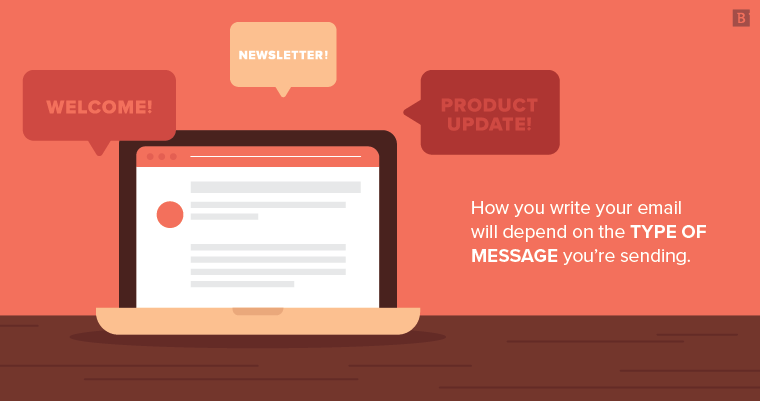
How you write your email will depend on the type of message you’re sending.
Let’s cover best practices for some of the most common email types before we get into more general writing tips:
Welcome Emails
Send these emails after someone entrusts you with their email address. For instance, a consumer signed up for a mailing list while shopping at a store. Or an interested web user subscribed to your newsletter or downloaded a gated white paper.
A good welcome email should do three things:
- Be gracious (“thanks for subscribing!”).
- Tell you what to expect now that you’re signed up.
- Say something about who your brand is.
Here’s an example:
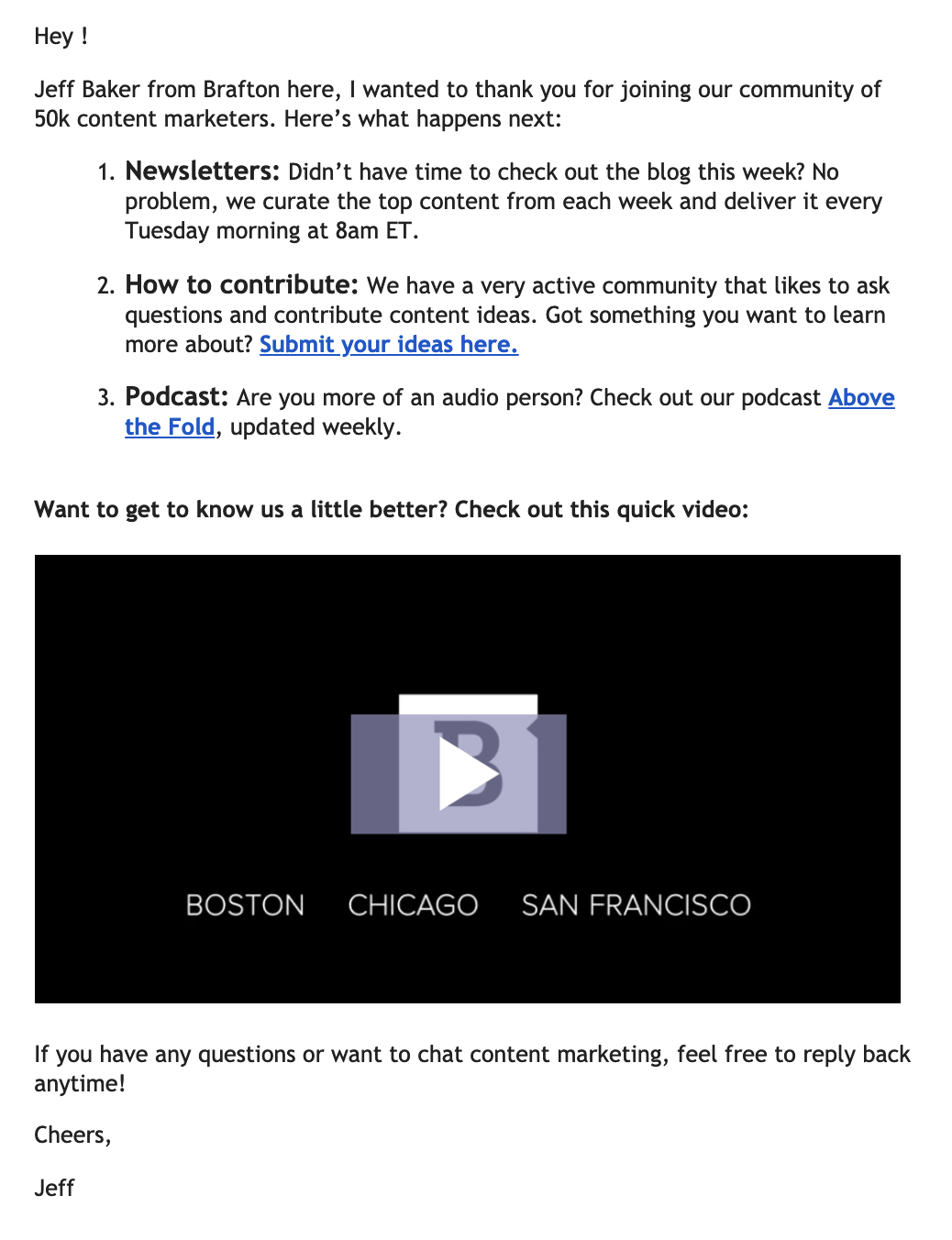
Notice how we included a video for the “who we are” portion of the email? That’s far preferable to an in-line manifesto.
You can’t see it in the image, but our subject line is “Welcome to the club!” Keep it simple, a little playful if you want, and always to the point.
Do not skip the welcome email. It has a higher open rate than most other types of engagement emails (nearly 60%) and a higher CTR (14 percent).
The high open rate should tell you that subscribers expect it. It’s the first impression your brand makes, and it can affirm they’ve made a good choice or send them running.
Prospecting Emails
Even the other name of this email (“cold”) juxtaposes the warmth of the welcome message. Prospecting emails are largely unsolicited and mostly ignored.
They often don’t work, but this doesn’t mean that they can’t work. The three most important “dos” of prospect emailing are:
- Get to the point.
- Give the reader information they can do something with. Prospecting emails aren’t introductions; they’re more like mini demonstrations of value.
- Give the recipient a single, clear action (should they contact you and, if so, how? Are they downloading something? Choice is the enemy here).
For example:
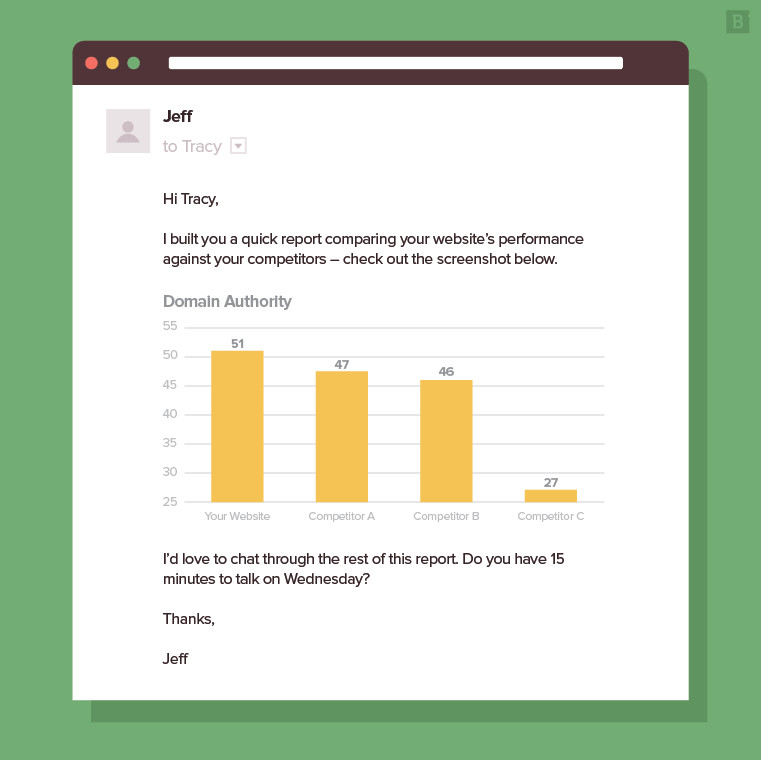
Other pointers?
Personalize. The example above very clearly targets a specific person (Tracy), ostensibly from a particular company, and most likely someone who can either influence or make a decision about actions to improve website performance. This is where segmenting really comes in handy.
Also, there’s a graph in there. You don’t necessarily have to use imagery, but it beats a big wall of text any day, and it can give the eye something to immediately latch onto.
Subscribe to
The Content Marketer
Get weekly insights, advice and opinions about all things digital marketing.
Thank you for subscribing to The Content Marketer!
Newsletters
A newsletter is an email series spotlighting the week’s (or day’s) content.
Because people opt into them, newsletters tend to have higher open rates than prospecting emails.
The hard part is keeping those open rates high and driving CTR (you want people clicking on links). We recommend:
- Concise copy in an elegant, eye-pleasing template. Your audience won’t tolerate too much text or overly busy design work. They want something digestible.
- A subject line that says something other than “[Company] newsletter.” Use the week’s top headline or a short and punchy sentence that summarizes the week’s theme.
- Copy that speaks for itself. Entice with strong headlines, a relevant or interesting thumbnail (preferably not stock) and a brief synopsis of why they should care.

(See more examples of newsletters we like, here.)
Other general tips:
- You can pepper in content from other sources if you think it’s relevant to your brand or in some way adds value or intrigue to your audience’s day.
- Feel free to recycle old content in a new context. On occasion, an evergreen post chases a recent study or news article quite nicely (especially if those breaking stories support your thought leadership).
- Try to be aware of the content sequence in newsletters, as CTR does drop farther down into the email. Descending order of importance or newsworthiness might be best one week, chronology might be better the next. On another week, there may be a benefit to arranging content in a very particular order. Just be mindful of opportunities to present newsletters that are more than smatterings of marketing content.
Also, your target audience cares about what’s on the other side of each click. The blog post, video or eBook has to be as good as the wrapping for them to keep opening emails and clicking away at the links.
Lead Nurturing Emails (and Specifically Drip Campaigns)
A lead nurturing email is broadly any email intended to move a lead closer to buying. You could probably argue that any marketing email that isn’t a transactional email is a lead nurturing email.
But we’ll sidestep the semantics for now and home in the microcosm of all lead nurturing emails: the drip campaign.
A drip campaign is an automated sequence of emails that adjusts the next message based on the action a recipient takes.
The main things to keep in mind for creating content for a drip email are:
- Create all your email copy before sending out a single message so each stage flows nicely into the next.
- Every word, from subject to sign off, should be centered around the single action that you want the user to take for that email.
- Play it cool. Don’t send one email right after the other, because that’s basically spam (and it’s a bit desperate).
Not all of the lead nurturing emails you send will be part of a drip campaign. Maybe you’re conducting a survey. Or maybe a compelling white paper or ebook would delight specific contacts on your email lists (say, mid-level managers in accounts receivable), and you want to make sure they see it.
Fair game, go for it. But don’t do it too often, or you’ll seem spammy.
Event Invitation Emails
Event invitation emails can promote a webinar, attendance at a conference, your own expo, a company lunch and learn or some other event.
Some marketers think more information in the body of the email is better, which is why you might come across something like this on a list of “great” event invitation emails:
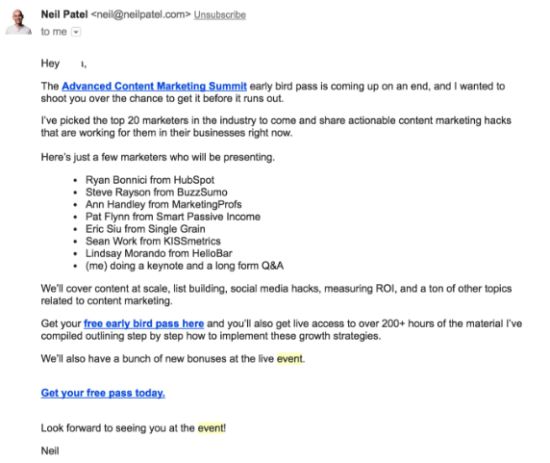
We love Neil, and he certainly provides solid information in this email. One could even argue that these types of messages are part of his brand.
But we hold fast to the philosophy that shorter is better. The reason?
- You’re not Neil Patel. You may have some solid brand recognition, but people are very choosy about the sender when it comes to combing through 200 words.
- Data. Boomerang’s analysis of 40 million emails found that 50-125 words is the ideal length if you want people to respond or take some other desired action.
- Landing pages. This is where all the event’s nitty-gritty details and information should live. Your email’s job is simply to build interest with the basics (who, what, when, where, why and how to learn more).
Also, there aren’t a lot of clear calls to action in Neil’s message, and there’s almost nothing going on visually.
Here’s an example of an event email follow-up from a different bald guy that gives all the most important information up front, has copy that conveys a sense of urgency (using numbers, no less) and finishes with a strong CTA:

For the actual event invitation, you can lean a little more into visuals like in this example:

It tells you the name of the conference, the date, where it’s happening, what it is (“Two full days of insights”) and encourages signup (“Get your tickets now”) within the first fifth of the email.
As for subject lines?
Keep them action-oriented and to the point. If the event is obscure, lead with the value (“Learn X at [event]” or “Master X during [webinar]”). If the event carries clout, then lead with it (“Join us at X for Y” or “We’re going to X: Attend our keynote address about Y”).
Product Updates
These email messages promote new products, services, features, templates and other updates of interest to existing users or customers.
Don’t gloss over product update emails. They play an important part in the customer journey—upsells, rebuys, moving freemium users to for-pay users and building loyalty.
When it comes to crafting them, context is everything. For example:
New features for freemium users
You’re Canva and you just added some new design layouts for users. Something like this passes with flying colors:
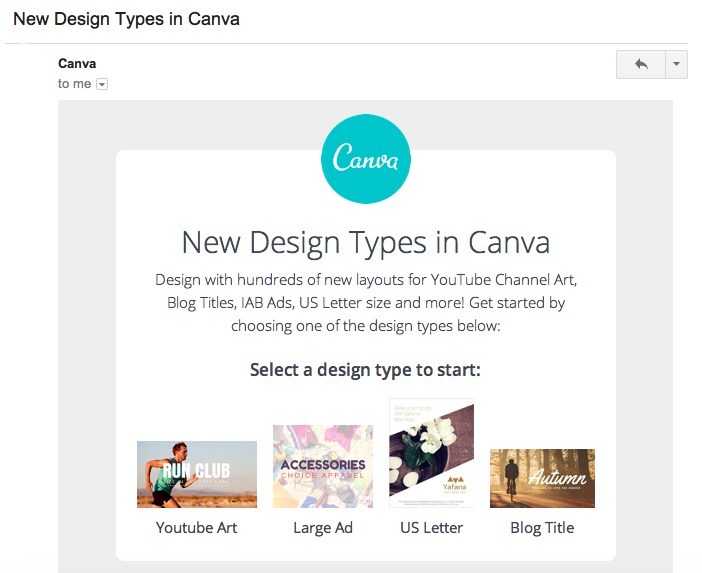
It’s simple, to the point and it links straight to the new goods.
Big updates to your product or service
On the opposite end of the spectrum, let’s say you’re a software-as-a-service vendor who just made a significant update to your application.
In this case, you need to craft emails from a customer service mindset because change can be scary. Always take a positive, reassuring tone, be forthright about what’s changing, briefly explain why it’s better, link to any tutorial or help resources, and make yourself very available for support or questions.
Keep in mind that some clients won’t like learning about big changes that affect their day-to-day operations through mass email, and may require a more personal touch.
Everything in between
Maybe you added new metrics or dashboard to one of your apps. Or perhaps you just released a new feature on the for-pay version of your app or service that might also sway free users.
Whatever the case, keep a few things in mind:
- Your audience. Does the update pertain to them?
- Targeted messaging. For example, if you’re using a product update to get freemium users on the for-pay version, create two emails: a basic one informing existing for-pay users, and a lead-nurturing email incentivizing freemium users.
- Tone. It should be informative, brimming with new possibilities and, in the case of much bigger overhauls, reassuring.
Transactional Emails
Transactional emails are updates about any account activity.
Examples include onboarding emails, order confirmations, delivery updates, setting adjustments, security notifications, payment reminders, etc.
They have the highest open rate of all other types of email by a long shot. This is because they convey basic information that’s of great value to existing customers.
Most service providers and retailers rely heavily on email automation for transactional outreach, and they generally require a bit less craft than say, lead-nurturing emails.
Other Types of Emails?
There are plenty we won’t have the chance to discuss here, but a few that deserve mention include:
Surveys, interactive quizzes, requests for reviews
These engagement emails help you collect information that can be used to create new content, further personalize your email marketing and turn existing customers into brand advocates, respectively.
Deals and promos
The approach should closely mirror an event email. You want that same sense of urgency and forthcomingness about what product or service is on sale, when, where and how to cash-in on the discount or promo.
Cart abandonment
This is akin to a transactional email in that it’s typically automated, with a little bit of lead nurturing in the mix since you’re trying to spur purchasing behavior. They can be fairly basic like this one from Amazon:
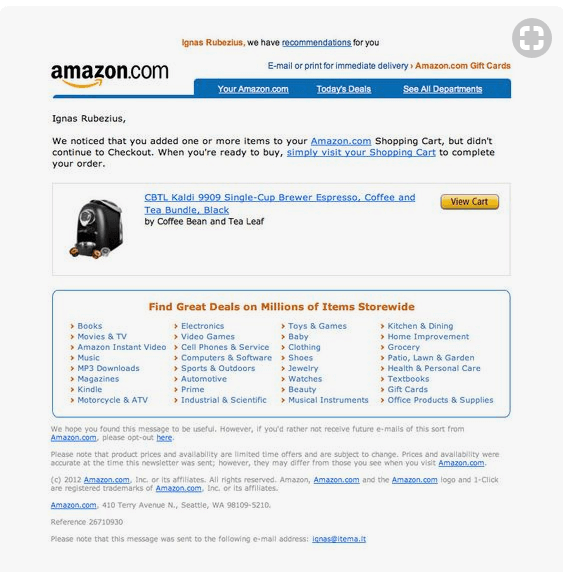
Or a bit more playful and visual like this one form Dollar Shave Club:
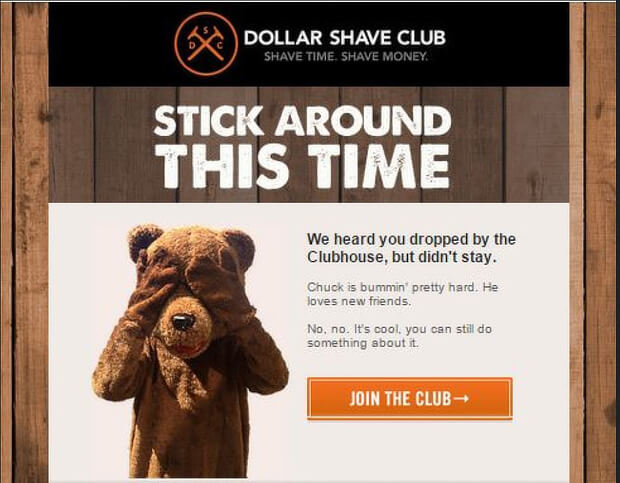
The idea is to nudge the shopper over the finish line with a simple reminder.
Finally, a Few Email Content General Best Practices
1. Give each email a single goal
Craft your email copy and design around that singular goal, and make it easy to achieve (CTA buttons that say “read more” or “start your free trial”).
2. Create pithy subject lines
You don’t want them too long because they’ll get cut off, or too short because they won’t convey meaningful information. Otherwise, data suggests there isn’t actually a relationship between length and open rate, just a few dubious correlations. We’d say around 55-65 characters makes sense in terms of logistics (getting the point across and displaying the entire subject).
3. Don’t spoil endings
Curiosity works in the email marketer’s favor. “Find out which WordPress plugins marketers use most” gives more of a reason to click than just saying the answer outright.
4. Be concise and conversational
Use first names, and say things in simple language. It makes the message feel a little more intimate and disarming.
5. Use active language and short sentences
You only have a few seconds to make your point, so make it fast.
6. Break up copy to make it more scannable
Make one point per paragraph and use bullets when listing things.
7. Use second person pronouns
Uncle Sam doesn’t want that guy over there. He wants you!
8. And first person, too
We, I, us and our convey humanity.
9. Personalize, but not too much
Personalization is good when you reach out to a prospect about a demo after they download a product-specific eBook. It’s bad when Target breaks the news to a man that his teenage daughter was pregnant (true story).
10. Embed imagery in moderation
Graphics, charts and GIFs all have their place in email, but a hyper-polished look is easy to associate with spam. Even Google is into textural design these days, so don’t overdo it.
11. Create multiple drafts
Not just for A/B testing, but because it’s rare that you’re first draft is your best or your most concise.
12. Keep mobile in mind
About 50% of all emails are viewed on mobile devices. A poorly optimized email template can drastically reduce your engagement chances, and users will often unsend an email within 3 seconds or less if it fails to load properly.
13. Don’t be spammy
Roughly 20% of permission-based emails end up in junk folders. Evading spam filters today is less about using a dedicated IP address and more about being smart. DMARC report check-ups can help guarantee your domain is secure and not spammy. Always send welcome emails, grow lists organically instead of buying them and follow the law—like including an “unsubscribe” button and a physical mailing address. (MailChimp has a few more useful tips.)
Knowing Your Audience
Of course, all of this information comes with the huge caveat that you must know your audience well. There’s no one-size-fits-all solution for building an email campaign, so your results may vary depending on who your recipients may be.
The language, style and tone of your emails also largely depend on who it is you’re writing to. Take some time to decide on your brand voice on all your digital platforms – emails included. Test the waters and see how your audience reacts. If you know that your email content has a high click-through and open rate with personalization and a few promotions here and there, maybe you’ve found your content marketing calling.
Use audience analysis to dictate how you want your email campaign to go, and you’ll quickly see results—and less of your emails in the spam folder.
Measuring Your Results
As you employ these best practices across your email campaigns, the key performance metrics you’ll want to track include:
- Bounce rates: Percent of recipients who never receive your emails in their inbox. Inversely, you can track this as deliverability rate (those who do receive the emails). High bounce rate likely indicates problems with your email lists.
- Open rates: Percent of recipients who open your emails. Pay attention to which messages see the best open rates.
- CTR: Percent of recipients who clicked on the links in your emails.
- Conversion rates: Percent of recipients who completed a particular action after clicking through (they successfully registered for a demo or event, for instance).
- Unsubscribe rates: Percent of recipients who no longer want to be subscribers. It’s OK if they’re relatively high, especially in the early days.
- Complaint rates: Percent of recipients who mark your email as spam. This is also known as abuse rate.
An objectively good rate for these metrics can vary by industry.
For example, CTR is highest in the hobbies industry (4.78 percent) and lowest in public relations (1.63 percent). Across the board, it’s 2.43 percent.
As for ROI: In theory it’s just the amount of money the campaign brought in minus the amount spent.
Recurring expenses like monthly cost of your email service and marketing automation platform are fairly easy to tally up.
Time and effort put into crafting email content is harder to track. And attribution (figuring out the exact piece of content responsible for a sale) is notoriously challenging.
Still, email technology is objectively cheap, and attribution is easier to pinpoint than for most other content marketing channels.
More importantly, most B2B marketers (74%) say email is their most successful method for distributing content. Among B2C marketers, email is cited as one of the most effective channels for achieving specific marketing goals.
Our advice on ROI?
You’re welcome to take a stab at finding a dollar figure. Some businesses like Sleeknote and Sendgrid provide free online tools that help make the calculations for you.
But that’ll just give you a number without very much context.
Close scrutiny of engagement metrics will show you precisely what you’re doing well and where you’re falling short. In other words, they’ll tell you if you’re doing email marketing right.
And once you’re doing it right, we can begin to take a harder look at that $44 figure.
Editor’s Note: Updated August 2021.





